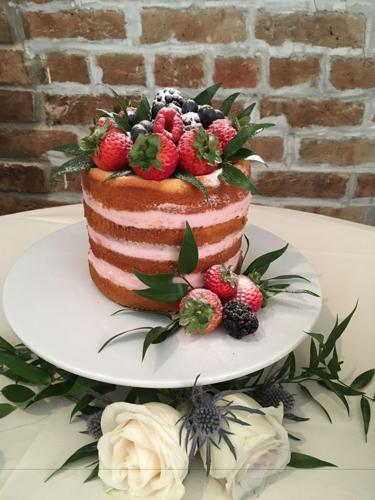Desserts. They're the treat at the end of the meal, the pat on the back after eating your Brussels sprouts and cleaning your plate. The dessert course can be as simple as a spoonful of ice cream, eaten out of the container while standing over the sink, or it can be more elaborate, like a genoise cake covered in raspberry-infused dark chocolate ganache and topped with candied kumquats. Whatever your style, sweets are an integral part of dinner.
When planning a party, consider your guests' tastes and the menu for the rest of the meal before deciding on a dessert to serve, especially when working with a professional. Does the event call for a whole cake or pie, or are small bites more appropriate? Do your guests crave familiar confections such as vanilla cake with buttercream icing, or will they appreciate something savory and different, such as pastry-wrapped baked brie with a honey glaze?
"[Some of] my clients want traditional desserts like a whole apple pie," says Melissa Araujo, executive chef of Saveur Catering. "It's simple and it's elegant. Some clients are looking for comfort food like dulce de leche or tres leches or napoleons."
Cheryl Scripter, owner of Bittersweet Confections, says hosts should consider all the details of a party before deciding on a dessert offering, especially the overall vibe of the event.
"If it's something really casual like a crawfish boil, I may do a twist on really fancy desserts just to change things up," she says. "Or for an engagement party I may want to do some small, all-white desserts like mini meringue bites ... or white chocolate covered strawberries."
Honey — oh, sugar, sugar
Bite-size and two-bite sweets are trending, but Scripter has many clients that still want something beautiful and elaborate for the center of the table. Naked cakes (cakes without a coating of frosting) are popular, but Scripter and her team throw in a few twists of their own, including a bittersweet tiered king cake with chocolate and traditional glazes, and croquembouche, a tower of French choux pastry drops held together by caramel.
Scripter likes preparing dessert bars for her clients because it presents guests with a variety of sweets. She says there are five categories of confections: nutty, fruity, chocolate-based, crunchy and soft. If hosts offer at least one of each, there's sure to be something for everyone.
Scripter's first confectionary love is chocolate — chocolates from different countries, chocolate truffles and chocolate-covered berries.
"Or I'll just make several different chocolate ganaches and flavor them and make shooters," she says.
For summer, she likes desserts that are "light but meaningful" — treats like mini tarts with vanilla pastry cream topped with fresh berries.
"You can take advantage of all your beautiful summer fruits ... blackberries, blueberries and raspberries," she says. "Or you can do a tart shell (filled) with lemon curd and topped with blueberries. It's something small but very flavorful and light."
Araujo also suggests lighter desserts for the warmer months, like a strawberry shortcake made with homemade biscuits instead of shortcake ("It's not as heavy," she says) or refreshing citrus-flavored confections, especially Key lime pie.
Savor the moment (and the dessert)
Savory flavors are infiltrating the sugared ranks of dessert offerings this year. Treats such as apple cider-based creme caramel mousse and s'mores with slabs of bacon combine sweet, salty and tangy flavors.
Araujo enjoys crafting savory sweets.
"A lot of my classical, savory desserts come from my Italian heritage, [such as] melons wrapped with prosciutto and topped with balsamic vinegar, or figs stuffed with blue cheese then broiled in the oven quickly and topped with honey infused with lemon juice, thyme and lavender," she says. "I love to infuse honeys ... and put it on top of fruit."
Herbs, acids such as balsamic vinegar and salty items such as prosciutto can provide balance in a dessert. Salt can enhance sweetness, especially with fruits, because it diminishes the mouth's perception of acidity and allows you to taste sugars more fully. Herbs add an aromatic element.
Another of Araujo's favorite savory desserts is Honduran style rice pudding made with Carolina Gold rice and whole milk. The dish gets its sweetness from grapes, raisins and Mexican Ceylon cinnamon.
So, what's the plan?
Araujo says it's important not to get over- zealous when planning the dessert course of a dinner party.
"Don't overstretch yourself," she says. "Consider how much time you will have to do the prep work. Make sure it's something you feel comfortable cooking."
She advises hosts to write a list of all the courses they intend to serve, the ingredients list and shopping list for all items and to really look at the hands-on time involved in cooking.
"Write down your notes, then come back to it later and check that you still feel solid about it," she says. "Ask, 'Do I really need to even make dessert myself?' If you're making something like a tart, can you buy the crust (premade)?"
But that isn't to minimize the importance of the dessert course — Araujo and Scripter believe it's the anchor of the meal, and the part (whether they admit it or not) guests look forward to the most.
"That has to be the show stopper," Scripter says. "You have to save room for dessert. I would serve dessert first. Make a few things that you love — people like to share the things that they love with the people they love. Make it easy, quick and light. It's summer. It's too hot to fight with anything."



